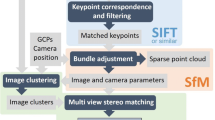Abstract
Missing availability of reliable and specific landscape data may pose substantial restrictions to successful exploitation of remote sensing data and fast implementation of GIS (Geo-Information Systems). The possibilities to document conditions with high spacialFootnote 1 resolution at a given time and to review changing aspects by different disciplines represent opportunities for complex environmental programs.
The article covers: geodata acquisition and processing, research, execution, and ergonomical/cognitive aspects. Application in inpenetrable terrain for research, landuse, and engineering requirements proved the feasibility especially in areas with high demand for timely, accurate, and comprehensive surveys.
Airborne close-range sensing was developed to survey localities and regions. It is no competition to global-change monitoring and large area are mapping programs possible with remote sensing. Substituting only the bulk of field-work, leaving time for in-depth review in the field or in the office, the system provides a possibility to restudy points of interest.
Exploitation of advanced metric cameras, specialized airborne platforms, and spatial overlay, recognition, and discrimination techniques form the backbone of the TOPOGRAMM approach. Multi-sectoral, multi-temporal, multi-spectral survey and processing methods rely basically on enlarged image scales additional to conventional aero-photogrammetry and analytic plotting. Measurements and identification, not primarily interpretation, allow to establish high-fidelity and high resolution geo-frameworks. Focussing on micro- and mesoscales, no emphasis is given to highest geometric accuracy used for geodetic surveys. Drawing near to the object allows extraction of thematical and semantical information, dimensions, and phenomelogy of objects hitherto only singularily available.
Similar content being viewed by others
Notes
disticntion is made between \lsspacial\rs (three-dimensional) and \lsspatial\rs (two-dimensional)
References
ADV: Amtliches Topographisch-Kartographiches Informations-system (ATKIS), Arbeitsgemeinschaft der Vermessungsverwaltung der Länder der Bundesrepublik Deutschland, Landesvermessungsamt, Bonn 1988.
AFL — Arbeitsgruppe Forstlicher Luftbildinterpreten: Auswertung von Color-Infrarot-Luftbildern, Selbstverlag der Arbeitsgruppe, Freiburg-Wien 1988.
Benking, H.: Airborne Close-Range Sensing Yields Analysis of Local Ecological Changes, In: Proceedings Ecoinforma Conference, Bayreuth 1989.
Benking, H.; Lessing, H.: Large Scale Biomonitoring for Renaturation, Geoökodynamik 10,2/3, 277–290 (1989)
Carol, H.: Zur Theorie der Geographie. Mitteilungen der österreichischen Gesselschaft 105 I/II, Wien (1963)
Castri, Di, F; Hadley, M.: Enhancing the Credibility of Ecology: Interacting Along and Across Hierarchical Scales, GeoJournal 17.1, 5–35 (1988)
Curran, P.; Foody, G.; Kondratyev, K. Y.; Kozogerov, V. V.; Fedsschenko, P. P.; (eds.) Remote sensing of soils and vegetation, Taylor & Francis, London-New York-Philadelphia 1989.
Ebner, H.; Reinhardt, W.; Hößler, R.: Generation, Management, and Utilization of High Fidelity Digital Terrain Models, Proceedings IAPRS 27, B11, III, 556–566, Kyoto 1988.
Hobbie, D.; Rüdenauer, H.: The ZEISS PLANICOMP family: A user oriented solution for practical requirements, Bu 3a, 134–142 (1984)
Kampffmeyer, U. B.; Benking, H.: Die Gewinnung, Auswertung und Archivierung verläßlicher Umweltinformationen am Beispiel TOPOGRAMM, In: Informatik im Umweltschutz 4. Symposium, Hersg, Jaeschke, A.; Geiger,W.; Page, B.; Informatik 3achberichte 228, pp. 85–99. Springer Verlag, Heidelberg 1989.
Lanzl, F.: Digitale Cameras für metrische Anwendungen, hand-out, 42. PHOTOGRAMMETTRISCHE WOCHE, Stuttgart 1989.
Meentemeyer, V.; Box, E. O.: Scale effects in landscape studies. In: Goigel Turner, M. (ed.), Landscape hetereogeneity and disturbance, pp. 15–34. Ecological Studies 64. Springer Verlag, New York 1987.
Meier, H. K.: Progress by forward motion compensation for ZEISS aerial cameras, BuL, 3a (1984)
Rhody, B.: Ein kombiniertes Inventurverfahren mit photogrammetrischen und terrestrischen permanenten Stichproben für Intensiv-und Großrauminventuren, Forstwirtschaftliches Centralblatt 101, 1, 36–48 (1982)
Rhody, B.: Luftaufnahme repräsentativer Streifen- und Photostichproben mit kleinformatigen Nicht-Meßkameras, BuL 55, 2 (1987)
Ringler, A.: Gefährdete Landschafts-Lebensräume auf der Roten Liste — Eine Dokumentation in Bildvergleichen, BLV, München 1987.
Tamsley, A. G.: The use and abuse of vegetational concepts and terms, Ecology 16, 224–307 (1935)
Author information
Authors and Affiliations
Rights and permissions
About this article
Cite this article
Benking, H., Schmidt v. Braun, H. Geo-/Object-Coding for Local-Change Assessment. GeoJournal 20, 167–173 (1990). https://doi.org/10.1007/BF00196748
Issue Date:
DOI: https://doi.org/10.1007/BF00196748




